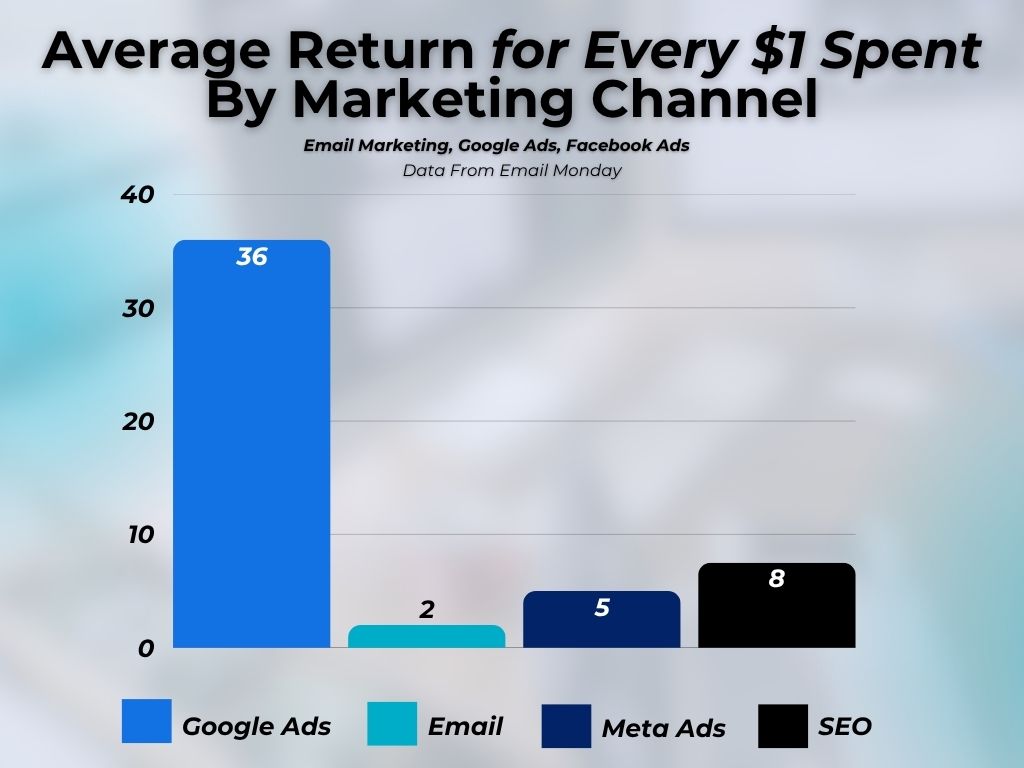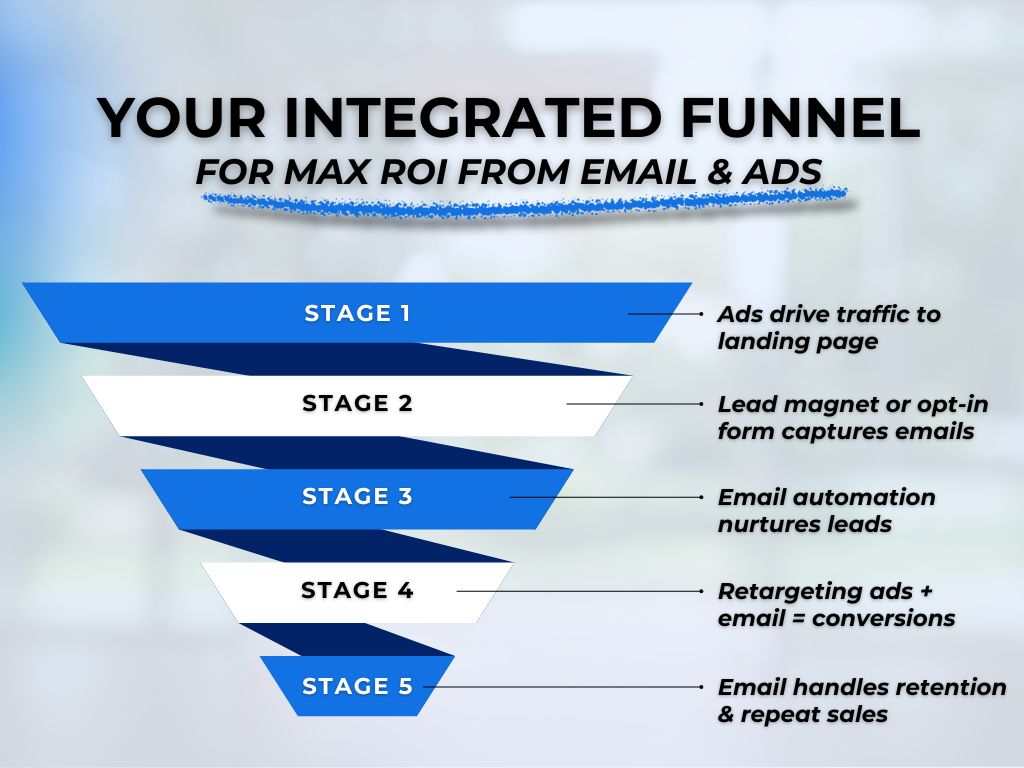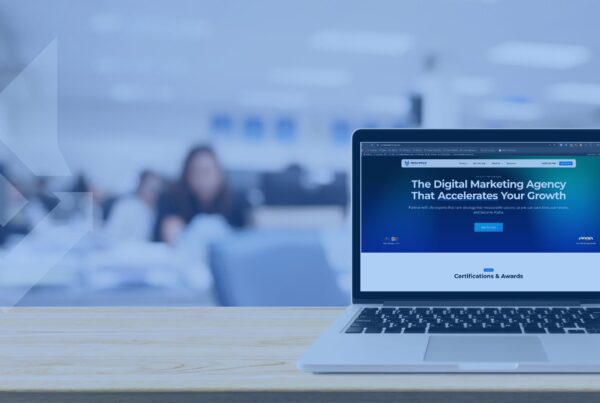You have $5,000 to spend on marketing next month. Should you put it into Facebook advertising, Google search campaigns, or your email list for the best ROI?
Most business owners assume advertising is the only real way to scale. But the numbers tell a completely different story.
According to data from Litmus, email marketing delivers more than $36 back for every $1 you spend. That’s an average return of 3,600% to 4,200%. But even half of that insane ROI puts your business right where you want to be.
This also doesn’t mean advertising is worthless. It means you need to understand what each channel actually delivers and how they work together. Let’s get to it.
Contents
What ROI Actually Means & Why Most People Calculate It Wrong
ROI stands for return on investment. It measures how much profit you make compared to what you spent on a campaign.
For example, if you invest $1,000 in Google Ads and generate $3,500 in revenue, your ROI would be 250%. That means for every $1 you spent, you earned $3.50 back before factoring in your business costs.
At WolfPack, we typically consider 350% or higher a strong ROI for ad campaigns, and many of our clients exceed that benchmark.
The basic ROI calculation formula:
(Revenue from campaign – Cost of campaign) ÷ Cost of campaign × 100 = ROI%
Whether you’re looking at email or advertising, ROI matters more than clicks, impressions, or followers. Those numbers don’t pay your bills.
A campaign with 10,000 impressions and zero sales has a bad ROI. A campaign with 100 clicks and $5,000 in revenue has great ROI.

Email Marketing vs Advertising: The Breakdown
Let’s cut to the chase and look at what each channel actually delivers.
| Channel | Average ROI | Best For | Key KPIs | Est Time to Results |
|---|---|---|---|---|
| Email Marketing | $36–$42 per $1 spent (3,600–4,200%) | Customer retention, repeat purchases, nurturing | Open rate, click-through rate, conversion rate, revenue per send | Immediate to 3 months |
| Google Ads / PPC | $2 per $1 spent (100%) | High-intent searches, immediate needs | Conversion rate, click-through rate, cost per conversion | Immediate |
| Facebook / Instagram Ads | $2–$5 per $1 spent (200–400%) | Brand awareness, product discovery | Click-through rate, cost per lead, landing page conversion rate | 2–4 weeks |
| LinkedIn Ads (B2B) | $2.29 per $1 spent (229%) | B2B outreach, professional services | Click-through rate, form fills, cost per lead | 1–2 months |
| SEO | $7–$8 per $1 spent (700–800%) | Long-term organic traffic | Rankings, organic conversions, traffic growth | 9+ months |
Why Email Crushes Other Channels
You own your audience. Facebook can ban your ad account tomorrow. Google can double your cost per click next week. Your email list stays yours.
You don’t pay for every message. Once someone joins your list, sending them emails costs almost nothing. Send 10 emails or 100 emails without spending more money.
Automation works while you sleep. Set up a welcome series or abandoned cart emails once. They run automatically and keep making money month after month.
People actually want to hear from you. Someone who gave you their email already knows your brand. They’re warm leads, not cold strangers.
When Email Wins vs When Advertising Wins
Each channel has a job. The trick is knowing which tool to use when.
When Email Typically Dominates
- Customer retention and repeat purchases. You already paid to acquire these customers. Email keeps them buying without additional acquisition costs.
- Abandoned cart recovery. Someone almost bought from you. An email reminder converts 10% to 30% of these people with zero ad spend.
- Long sales cycle nurturing. B2B buyers take 6 to 12 months to decide. Email nurtures them the entire way without paying for each touchpoint.
- Personalized customer journeys. Treat different customers differently based on what they bought, how they behave, or where they live.
- Predictable, scalable profit. Once your email system works, you know exactly what revenue to expect each month.
If Email ROI Seems Low…
Before getting discouraged, check these metrics and work on improving them one by one.
- Open rate (indicates subject line and timing performance)
- Click-through rate (shows engagement with your content and offers)
- Scroll depth (measures whether people are reading your emails in full)
- Unsubscribe rate (flags message fatigue or misalignment)
Improving these metrics first almost always leads to better ROI later.
When Advertising Normally Outperforms
- Reaching cold audiences. You can’t email people who aren’t on your list yet. If you’re launching something new or entering a new market, you need advertising.
- Immediate visibility. Need leads today? Advertising delivers ROI this week. Email only works if you already have a list.
- Visual storytelling. Fashion, food, travel, and lifestyle brands benefit from the visual impact of Instagram, YouTube, or TikTok ads.
- Rapid testing. Test 10 different ad variations in a week and know what works. Email testing takes longer because you can’t bombard the same small list repeatedly.
- Precise demographic targeting. Want to reach 30-year-old women in Denver who like yoga? Facebook can do that. Email can’t target people who aren’t on your list.
If Your Ad ROI Isn’t Meeting Goals…
- Conversion rate (tells you if your offer or landing page is resonating)
- Click-through rate (shows if your creative or message grabs attention)
- Scroll depth and heat maps (help identify where users drop off on your landing page)
- Cost per conversion (reveals whether your spend is sustainable for your margins)
Refining these KPIs helps you improve efficiency, even if your ROI number isn’t where you want it yet.
In essence, advertising is for acquisition and awareness.
Email is for conversion and retention.
Which Channel Wins in Your Industry?
The best channel depends heavily on what you sell and who buys it.
Service-Based Businesses
Email dominates for service businesses. If you’re a consultant, contractor, agency, or professional service provider, email wins on customer retention and repeat bookings.
Your customers need reminders to book again. They need nurturing between projects. They refer friends when you stay top of mind. Email does all of that without spending more money each month.
Use advertising when you’re entering a new market or need to fill your calendar fast. Google Ads works well for emergency services. Facebook works for local awareness.
At WolfPack, we’ve seen service businesses double their repeat customer rate just by implementing consistent email nurturing sequences.
That’s pure profit because you already paid to acquire those customers once.
E-commerce and Retail
E-commerce sees the highest email ROI at $40 to $45 per dollar spent. Automated emails drive 37% of all email revenue while making up just 2% of total emails sent.
Facebook Ads deliver about 5.4:1 return for retail and product discovery. They work great for introducing new products or reaching cold audiences.
The winning move? Use your ads to grow your email list with lead magnets or first-purchase discounts.
Then use email to drive repeat purchases and build lifetime value.
B2B and Professional Services
B2B companies get $36 per dollar from email marketing. But B2B buyers take longer to decide and involve multiple people in the purchase.
Email excels at nurturing these long sales cycles. You can send educational content over 6 to 12 months that keeps you top of mind when they’re finally ready to buy.
LinkedIn advertising works for cold B2B outreach at 229% ROI. Webinars perform even better at 430% ROI because they let you demonstrate expertise quickly.
The smartest B2B strategy combines all three. LinkedIn drives awareness and leads. Webinars convert interested prospects. Email nurtures everyone else until they’re ready.
The Winning Strategy: Using Both Channels Together
The businesses making the most money don’t choose between email and advertising ROI. They use both strategically.
Here’s how an integrated approach would look:
Step 1: Run targeted ads on Google, Facebook, or LinkedIn to drive traffic to a landing page with a compelling lead magnet (free guide, discount, consultation).
Step 2: Capture email addresses from interested prospects. These are warm leads who raised their hand.
Step 3: Use email automation to nurture those leads with valuable content, build trust, and make offers at the right time.
Step 4: Show retargeting ads to people on your email list who haven’t purchased yet. The combination converts better than either alone.
Step 5: Stop advertising to people who have already bought. Let email handle repeat purchases and referrals.
This integrated approach delivers 8:1 ROI when tracked properly. You’re using each channel for what it does best.
Think of advertising as the top of your funnel and email as the engine that turns leads into customers and customers into repeat buyers.

5 Ways to Maximize Your Email Marketing ROI
Getting $36 to $42 back per dollar isn’t automatic, though, of course! Here’s how to actually achieve those numbers.
1. Segment Your Audience
Segmented email campaigns generate 760% more revenue than unsegmented blasts.
Simple segments to start with:
- New subscribers vs long-time customers
- People who bought Product A vs Product B
- Engaged readers vs people who haven’t opened in 60 days
- Different geographic locations, if you serve multiple areas
You don’t need 50 segments. Start with 2 to 5 meaningful groups, get comfortable targeting those, and build from there as needed.
2. Automate Your Workflows
Automated email workflows deliver 30x higher returns than one-off campaign sends.
Essential automations every business should have:
- Welcome series for new subscribers (3-5 emails over 2 weeks)
- Abandoned cart reminders (3 emails over 3-7 days)
- Post-purchase follow-up (thank you, how to use, review request)
- Re-engagement for inactive subscribers (after 60-90 days)
Set these up once, and they’ll work forever (with regular updates, of course).
3. Personalize Beyond the First Name
Personalized emails get 26% higher open rates.
Real personalization includes recommending products based on past purchases, sending content relevant to their industry, and referencing their specific actions on your website.
4. Optimize for Mobile
Almost half of all email opens happen on mobile devices.
Use a single-column layout, keep subject lines under 40 characters, and make buttons big enough to tap with a thumb. Test every email on your own phone before sending.
5. Keep Your List Clean
A dirty email list kills deliverability, which kills ROI. Also, list clean-up isn’t something you do once and forget about forever. This should be something you think about quarterly.
Remove hard bounces immediately, remove subscribers who haven’t opened in 180 days, and use double opt-in to prevent fake addresses.
A smaller list of engaged subscribers makes more money than a huge list full of dead addresses.
4 Ways to Improve Your Advertising ROI
If you’re going to spend money on ads, do it right.
1. Track the Right Metrics
Focus on cost per acquisition (how much you pay to get one customer), customer lifetime value (how much that customer spends total), and return on ad spend (revenue divided by ad cost).
If your customer lifetime value is $500 and your cost per acquisition is $100, you’re winning. If it costs you $600 to acquire a $500 customer, you’re losing cash.
2. Test Relentlessly
The difference between a profitable ad campaign and a money pit often comes down to small details.
Test headlines and copy, images and videos, target audiences, landing page variations, and call-to-action buttons. Test one thing at a time. Run tests long enough to get meaningful data (at least 100 conversions per variation).
3. Retarget Strategically
Retargeting ads (showing ads to people who have already visited your website) deliver better ROI than cold advertising.
Build retargeting audiences for website visitors who didn’t buy, people who abandoned their cart, past customers for new products, and email subscribers who haven’t purchased yet.
Scroll through WolfPack’s approach and results for this client’s advertising:
4. Use Ads to Grow Your Email List
The smartest way to spend ad money is by building something that lasts: your own email list.
Instead of sending ad traffic to a generic contact page, drive people to a simple offer that delivers instant value.
This could be a free guide, checklist, seasonal promo, or consultation. In exchange for an email, they get something helpful, and you gain a qualified contact you can market to again and again at no extra cost.
For service-based businesses, lead magnets like a home maintenance checklist, pest prevention guide, or “Save $60 on your next inspection” offer perform especially well.
These ads attract high-intent users, improve click-through rates, and give you an engaged list that fuels both short-term conversions and long-term ROI.
How to Choose Between Email and Advertising
Use this simple decision framework:
| Your Situation | Best Channel to Focus On | Why |
| You have 500+ engaged email subscribers | Highest ROI with audience you already own | |
| Marketing to existing customers | They already know you; no acquisition cost needed | |
| Need leads today | Advertising | Immediate visibility and traffic |
| Launching in a new market | Advertising | Reach cold audiences who don’t know you exist |
| Long sales cycle (6+ months) | Nurture leads over time without paying per touchpoint | |
| Visual product (fashion, food, lifestyle) | Advertising | Instagram/Facebook excel at visual storytelling |
| Goal is repeat purchases | 30x better ROI for customer retention | |
| Testing new offers quickly | Advertising | Get feedback in days, not months |
| Want maximum total revenue | Both | Ads build the list, email converts and retains |
We’d recommend that most established businesses spend 60-70% of their marketing budget on email and owned channels, and about 30% on advertising for new customer acquisition.
Common ROI Mistakes That Kill Your Returns
Even smart business owners make these errors.
- Not tracking at all. You’re flying blind and can’t improve what you don’t measure. Set up conversion tracking in Google Analytics and your ad platforms today.
- Using different attribution windows. Comparing 1-day ad attribution to 30-day email attribution makes email look better than it is. Use the same tracking window (usually 30 days) for all channels.
- Ignoring lifetime value. A customer worth $5,000 over 2 years isn’t the same as one worth $200. Calculate and track LTV by acquisition channel to make smarter decisions.
- Forgetting time costs. Your time or your team’s time is worth money, too. Include labor costs in your ROI calculations for accurate numbers.
- Stopping too early. Most channels take 30 to 90 days to optimize. Give new campaigns at least 60 days before judging performance!
The biggest mistake would be not tracking anything and making decisions based on gut feelings instead of your data.
Related Questions
What is email marketing?
Email marketing is sending targeted messages to a list of subscribers who’ve given you permission to contact them. It includes promotional emails, newsletters, automated sequences, and customer communications.
How long before I see results from email marketing?
If you already have an engaged list, you can see results immediately. Starting from scratch? Expect 2 to 3 months to build your list, set up automations, and start generating consistent revenue.
That’s still much faster than SEO, which takes 9+ months (but is still an essential part of your marketing overall).
Should I focus on email or ads first?
If you have zero email subscribers, spend $500 to $1,000 on ads to build your initial list with a lead magnet. Once you have 500+ subscribers, shift 80% of your effort to email.
Can email marketing work for my industry?
Yes. Email delivers a strong ROI across all industries. Service businesses use it for repeat bookings.
E-commerce uses it for abandoned carts and repeat purchases. B2B uses it to nurture long sales cycles. The tactics differ, but the ROI stays consistently high.
Conclusion
The smartest ROI strategy uses advertising to build your email list and email to convert leads into customers and customers into repeat buyers.
Each channel has a job. Advertising brings strangers to your door. Email turns them into friends and customers. When you use both strategically, you build a marketing system that compounds over time.
Not sure where your marketing dollars should go next? We help service businesses build integrated marketing strategies that maximize ROI across email, advertising, and every channel in between.





